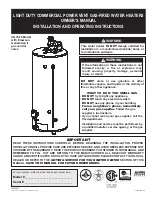
12
the new water heater. This new relief valve must meet
all local codes or, at a minimum, the requirements
listed above. Never install any other type of valve
between the relief valve and the water heater.
A discharge line must be installed into the relief
valve. The discharge line:
• Must not be smaller than the outlet pipe size of the
relief valve.
• Must not terminate less than six (6) inches (15.2
cm) and not more than twelve (12) inches (30.5
cm) above a floor drain.
• Must not be restricted in any way. Do not thread,
cap, or in any way restrict the end of this outlet.
• Must be of a material capable of withstanding
210
o
F (99
o
C) without distortion.
• Must be installed to allow complete drainage of the
relief valve and discharge line.
• Must terminate at an adequate free-flowing drain.
Pressure Build-up in a Water System
When the water heater operates, the heated water
expands creating a pressure build-up. This is a natural
function and is one of the reasons for installing a
temperature and pressure-relief valve. If the cold water
supply line has a built-in water meter, check valve, or
pressure-reducing valve, a suitable expansion tank
must be installed to prevent pressure build-up or water
hammer effect. Otherwise, the warranty is void (
see
Figure 11
). An indication of pressure build-up is fre-
quent discharges of water from the relief valve. If the
relief valve discharges water on a continuous basis, it
may indicate a malfunction of the relief valve, and a
qualified service technician must be called to have the
system checked, and the problem corrected.
Filling the Water Heater
NEVER
operate the water heater unless it is
completely filled with water. Failure to follow this
instruction can result in premature failure of the
water heater that is not covered by the warranty.
DANGER
WARNING
CAUTION
AVERTISSEMENT
ATTENTION
Check that all of the water piping connections have
been made. To fill the water heater:
1) Make sure that the water heater drain valve is
closed by inserting a flat head screwdriver into the
slot on the head of the drain valve and turning the
knob clockwise
.
2) Open the cold water supply manual shut-off valve.
This valve must remain open, as long as the water
heater is in use.
NEVER
operate the water heater with
the cold water supply manual shut-off valve closed.
3) To make sure the water heater is completely full of
water, open hot water faucets to let the air out of the
water heater and plumbing system. Leave the fau-
cets open until a constant flow of water is obtained.
4) Check all of the plumbing connections to make
sure there are no leaks.
Gas Connections
DO NOT
attempt to use this water heater with
any gas other than the type of gas shown on the
water heater rating plate. Failure to follow this
instruction can result in property damage, personal
injury, or death.
DANGER
WARNING
CAUTION
AVERTISSEMENT
ATTENTION
The gas piping must be installed as indicated in
Figure 11
. For the correct size of piping for this water
heater, consult CAN/CSA B149.1, National Gas and
Propane Installation Codes (in Canada) and/or the
National Fuel Gas Code, ANSI Z223.1/NFPA 54, in the
United States. Only new piping with cleanly cut
threads may be used, together with a suitable sealing
compound that is approved for natural and propane
gases. It is mandatory that a readily accessible manual
shut-off valve be installed in the gas supply line. The
gas supply manual shut-off valve must be close to the
water heater. A drip leg (sediment trap) must be
installed in the gas line ahead of the gas control valve
to prevent dirt from entering it. A union must be
installed between the gas control valve and the gas
supply manual shut-off valve for easy maintenance of
the water heater.
NEVER
use an open flame to test for gas leaks. A
fire or explosion could occur resulting in property
damage, personal injury, or death.
DANGER
WARNING
CAUTION
AVERTISSEMENT
ATTENTION
The water heater and its gas connection must be leak
tested before placing the appliance into operation. To
leak test the system:
1) Turn on the manual gas shut-off valve near the
water heater.
2) Use a soapy water solution to test all connections
and fittings for leaks. Bubbles indicate a gas leak.
3) Correct all leaks.
INSTALLATION INSTRUCTIONS













































